Let’s talk about Ghanaian food. Not the sanitized, Instagram-perfect version you see in travel magazines, but the real deal—the kind of food that makes you sweat a little, laugh at yourself when you inevitably get it all over your hands, and then immediately order seconds because it’s just that good.
Ghanaian cuisine doesn’t apologize for itself. It’s bold, it’s spicy (usually), it’s carb-heavy (definitely), and it’s designed to be eaten with your hands while sitting on a plastic stool under a tree. If you’re looking for
portion control and delicate flavors, you’re in the wrong country. If you’re ready for some of the most satisfying, soul-warming food you’ll ever eat, welcome to Ghana.
Understanding Ghanaian Food Culture Before You Dig In
Before we get to the dishes themselves, let’s establish a few things that’ll help you navigate Ghana’s food scene without looking completely lost.
The Right-Hand Rule: You eat with your right hand. Always. Your left hand is for… other things. Even if you’re left-handed, use your right for eating. This isn’t just etiquette—it’s culture. That said, nobody’s going to arrest you for using a spoon, especially with soups.
It’s All About the Combinations: Ghanaian food operates on a simple principle: starchy staple + soup/stew + protein. The staple (fufu, banku, rice, etc.) is your base. The soup or stew provides the flavor and moisture. The protein (fish, meat, snails) gives you something to chew on. Eating just the staple alone would be like eating plain pasta without sauce—technically possible, utterly pointless.
Spice Levels Are Not a Joke: When Ghanaians say something is spicy, they mean it. The default seasoning includes Scotch bonnet peppers, which will absolutely wreck you if you’re not prepared. If you have a sensitive palate, always ask for less pepper. Saying “no pepper” will confuse people and might even offend them—pepper is life in Ghana—so go with “small pepper” or “chale, easy on the pepper o.”
Portions Are Generous: A single portion of most Ghanaian dishes could easily feed two people, especially if you’re not doing manual labor all day. Don’t be a hero and order multiple plates your first time.
Street Food Is Life: Some of the best food in Ghana comes from street vendors, chop bars (local eateries), and women carrying pans of food on their heads. The hygiene standards aren’t Western, but millions of Ghanaians eat this food every day and survive just fine. Use your judgment, go where you see lots of locals eating, and embrace the adventure.
Now, let’s eat.
The Staples: Foundation of Every Ghanaian Meal
1. Fufu (The King of Ghanaian Staples)

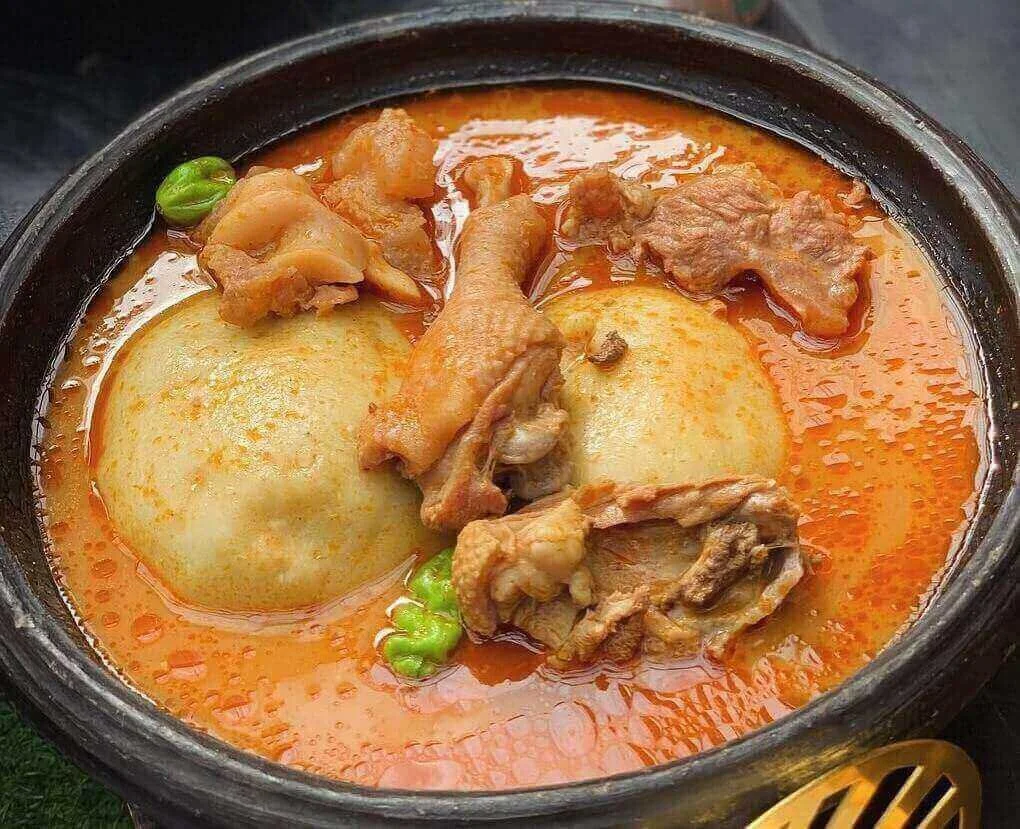

What it is: Pounded cassava and plantain (or sometimes yam and plantain, or just cassava) beaten into a smooth, sticky, dough-like consistency. If done right, it’s stretchy, almost elastic, and absolutely no lumps.
How it’s made: Traditionally, someone pounds boiled cassava and plantain in a giant wooden mortar with a pestle while another person turns the mixture. It’s rhythmic, it’s social, and it’s serious arm workout. These days, fufu machines exist, which is great because hand-pounding fufu is exhausting.
What it tastes like: Honestly? Not much. Fufu itself is bland and slightly sour (from the cassava fermentation). But that’s the point—it’s a vehicle for the soup. The texture is what matters: smooth, stretchy, swallowable.
How to eat it: Tear off a small piece with your right hand, make an indentation with your thumb (this creates a little scoop), dip it in the soup, grab some meat or fish if you can, and swallow it. You’re not supposed to chew fufu extensively—it’s meant to be swallowed relatively whole. This takes practice and feels weird at first.
Best paired with: Light soup, palm nut soup, peanut soup (groundnut soup), or any of Ghana’s signature soups. Fufu and goat light soup is considered peak Ghanaian cuisine by many.
Pro tip: If you’re intimidated by hand-eating, start with less sticky starches like rice balls (omo tuo) before attempting fufu. Also, fufu expands in your stomach, so don’t overdo it.
2. Banku (The Coastal Favorite)
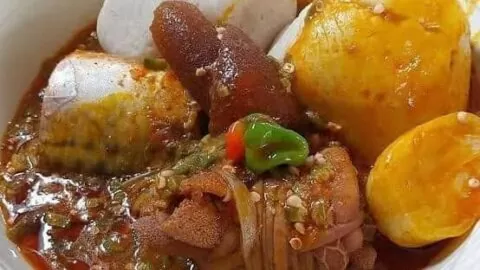

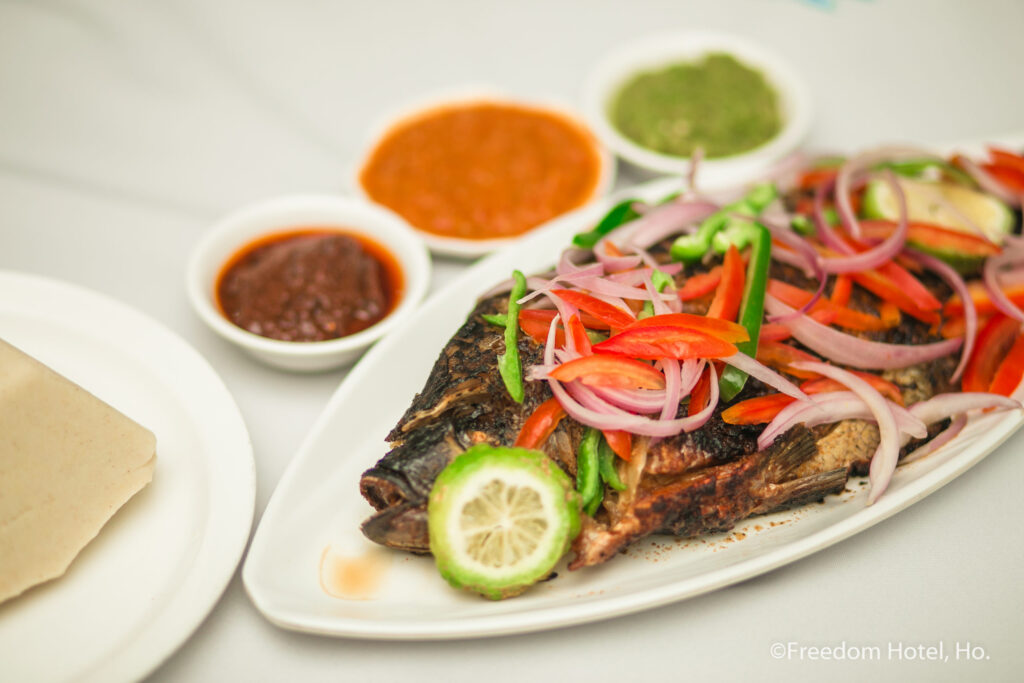
What it is: Fermented corn and cassava dough cooked with water until it becomes a firm, smooth paste. It’s then molded into a round or oval shape.
What it tastes like: Sour. Properly made banku has a distinctive tangy flavor from the fermentation that you either love or need time to appreciate. It’s smoother than you’d expect and slightly sticky.
How to eat it: Like fufu, tear off pieces and use them to scoop up your soup or stew. The sourness of banku pairs beautifully with rich, spicy, oily dishes.
Best paired with: Okro soup (okra stew), grilled tilapia with pepper sauce, fried fish with shito. Banku and okro is a combination so iconic that suggesting anything else might get you side-eyed.
Regional note: This is THE staple of Ghana’s coastal regions, especially among the Ga and Ewe people. If you’re in Accra or anywhere near the coast, you’ll see banku everywhere.
Pro tip: Fresh, hot banku is crucial. Once it cools and hardens, it loses its appeal. If you’re buying from a street vendor, make sure it’s fresh.
3. Kenkey (The Wrapped Wonder)


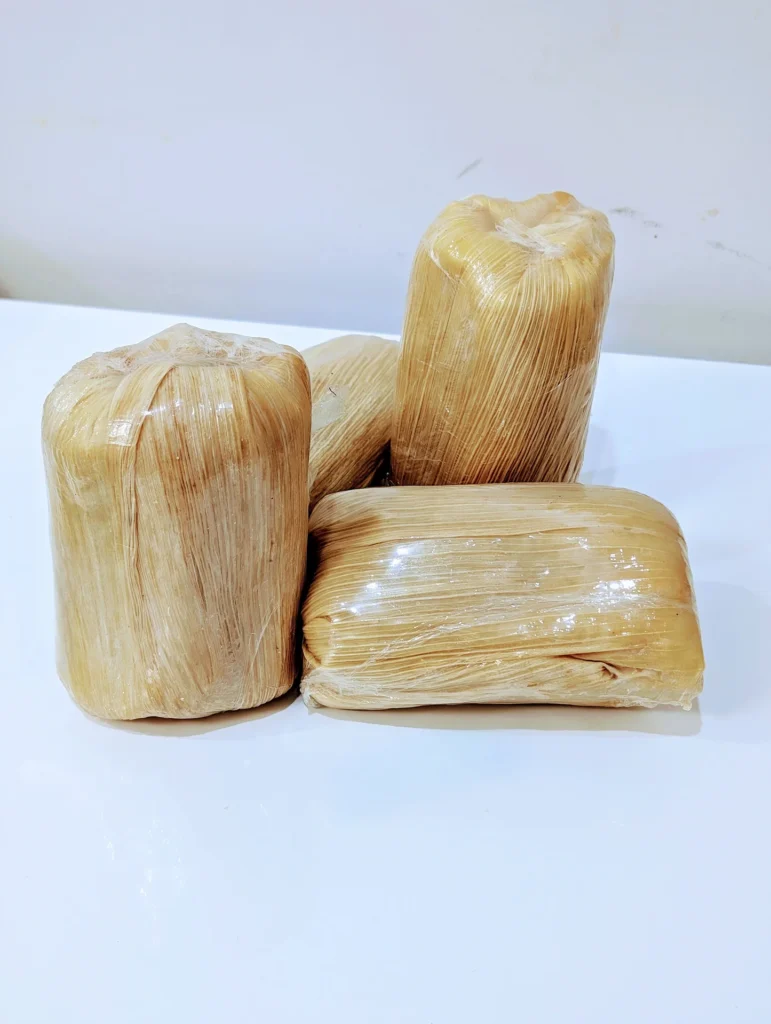
What it is: Fermented corn dough wrapped in corn husks or banana leaves and steamed or boiled. It comes in two main varieties: Ga kenkey (lighter, softer) and Fante kenkey (darker, firmer, more sour).
What it tastes like: Like banku’s more solid, more intensely sour cousin. The fermentation flavor is strong, the texture is dense and almost cake-like.
How to eat it: Unwrap it (careful, it might be hot), break it into pieces, and eat with fried fish, grilled fish, or any spicy pepper sauce. Some people eat it with avocado, which sounds weird but actually works.
Best paired with: Fried fish and shito (pepper sauce), grilled tilapia, hot pepper, kontomire stew.
Cultural note: Kenkey is called different names depending on where you are—”komi” among the Ga people, “dokono” among the Fantes. But it’s basically the same thing: fermented corn goodness.
Pro tip: Kenkey is filling. Really filling. One medium-sized kenkey plus fish is a complete meal. Don’t let anyone convince you to order two unless you’re genuinely hungry.
4. Waakye (Rice and Beans Done Right)
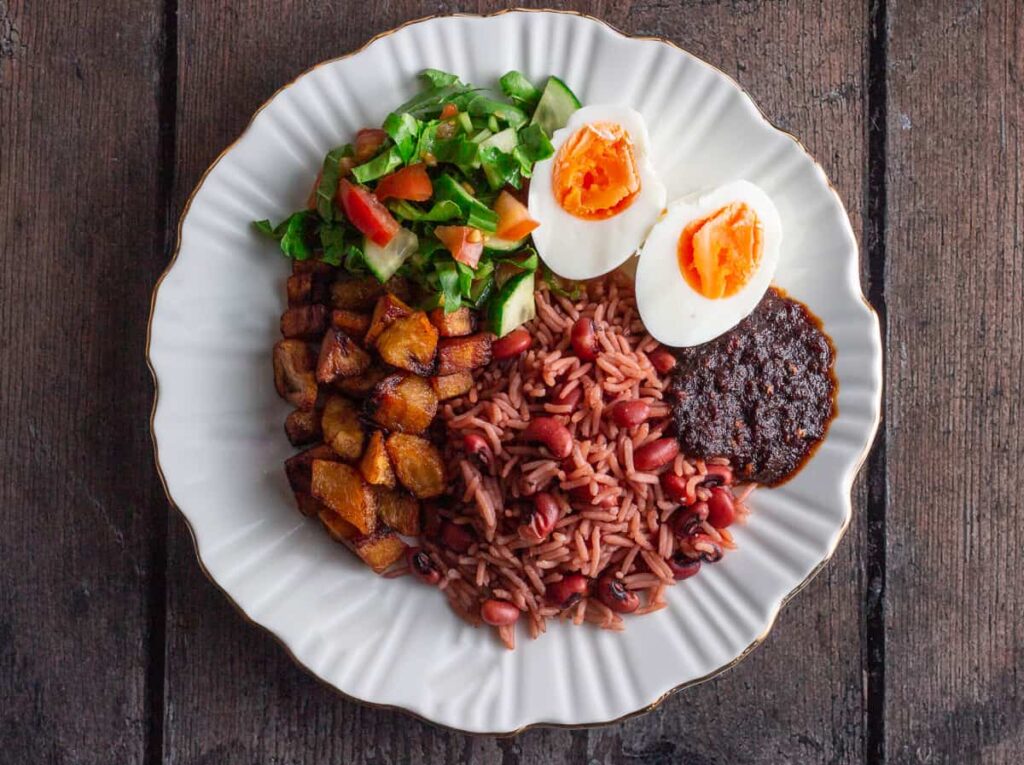
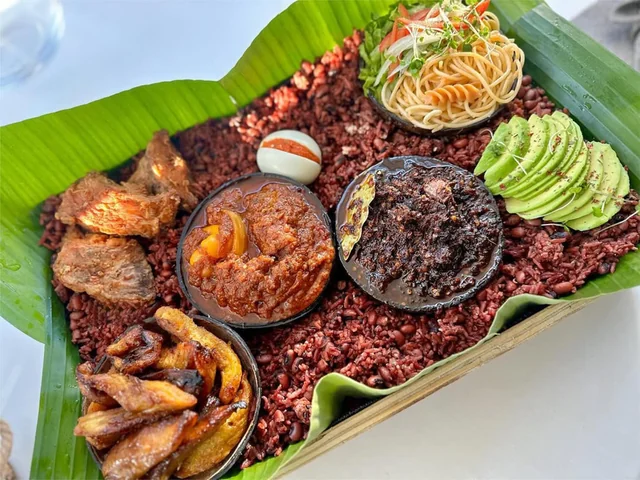
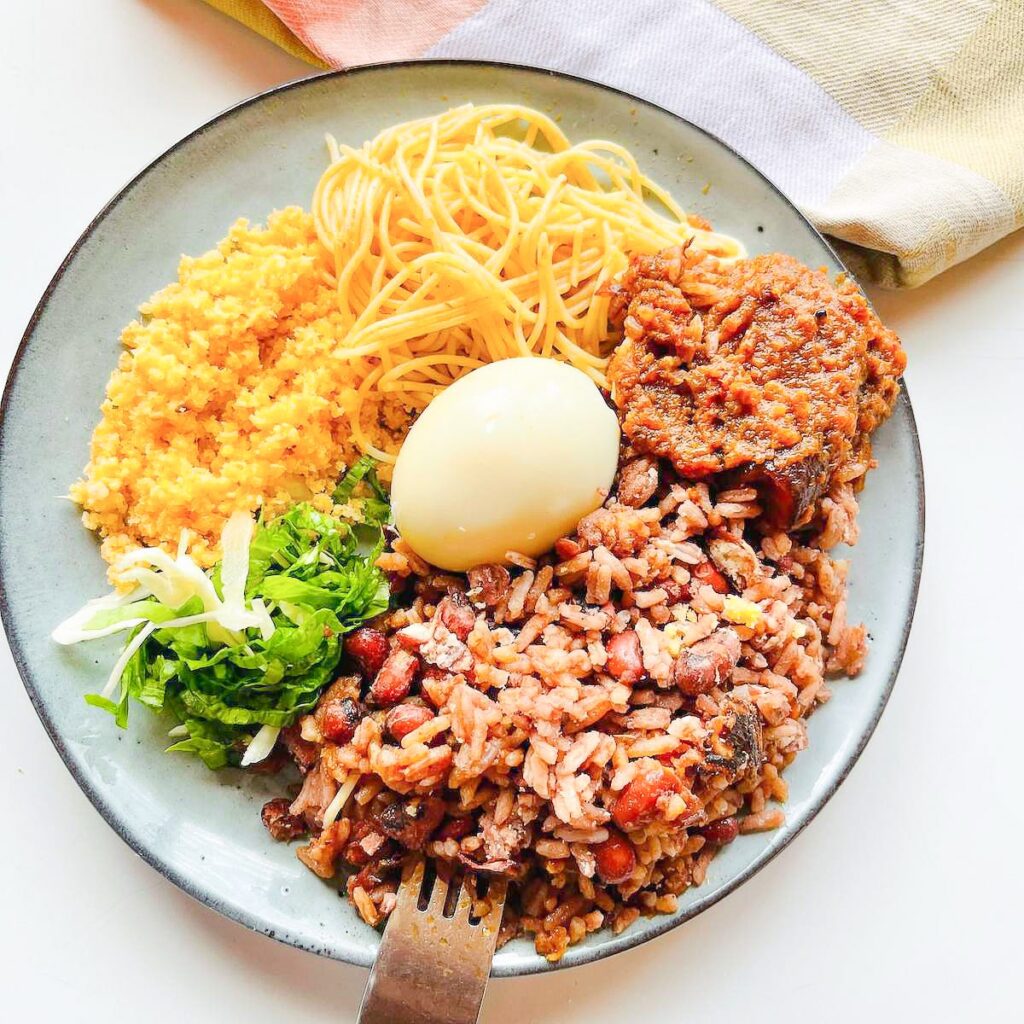
What it is: Rice and beans (usually black-eyed peas or cowpeas) cooked together with millet leaves (called waakye leaves) and sometimes baking soda, which gives the dish its characteristic reddish-brown color.
What it tastes like: Savory, slightly earthy from the leaves, with the comforting texture of perfectly cooked rice and soft beans. It’s filling and satisfying in the way only rice and beans can be.
How to eat it: Waakye isn’t usually eaten alone. It comes with an array of sides and toppings: fried plantain, spaghetti (yes, spaghetti on rice—don’t overthink it), gari (cassava granules), boiled eggs, avocado, meat or fish, and most importantly, shito (spicy black pepper sauce).
Best paired with: Stewed meat (especially beef or chicken), fried fish, shito sauce, fried plantain, boiled eggs.
Where to find it: Waakye vendors are everywhere in Ghana, especially in the mornings. They usually have all the components displayed in large pans, and you tell them what you want included. Waakye is breakfast food for many Ghanaians, though it’s eaten all day.
Pro tip: Start with “small waakye” even if you’re hungry. The portions are deceptive. Also, don’t skip the shito—that’s where much of the flavor lives.
5. Tuo Zaafi (Northern Ghana’s Pride)
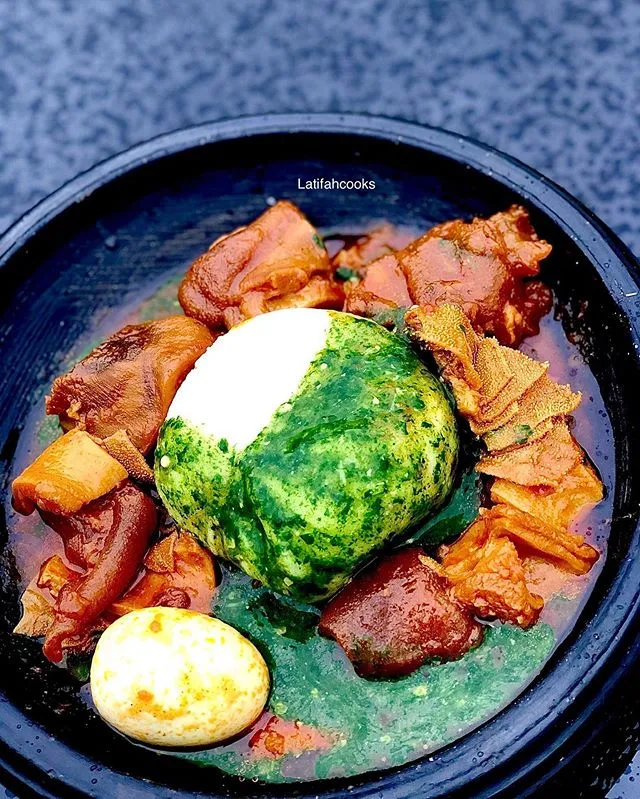

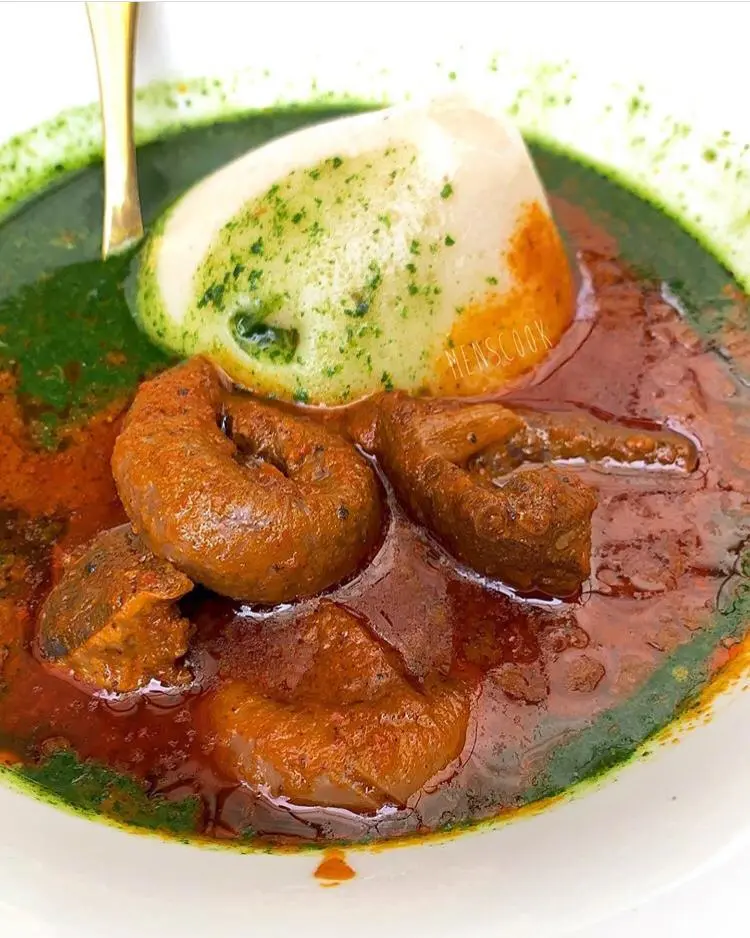
What it is: A smooth, silky dough made from corn flour or millet, cooked with water until it reaches a pudding-like consistency. It’s Northern Ghana’s answer to fufu, but softer and less sticky.
What it tastes like: Mild and slightly sweet if made with millet, more corn-forward if made with corn flour. The texture is velvety smooth.
Best paired with: Ayoyo soup (made with jute leaves—a Northern specialty) or any leafy green soup with dawadawa (fermented locust beans), which adds a distinctive funky, umami flavor.
Regional note: Tuo zaafi is to Northern Ghana what fufu is to the south. If you’re in Tamale or anywhere in the Northern, Upper East, or Upper West regions, this is what you’ll encounter most often.
Cultural note: The herbs and ingredients used in Northern Ghanaian cooking are quite different from the south. You’ll find more use of dawadawa, different greens, and a generally earthier flavor profile.
6. Omo Tuo (Rice Balls)
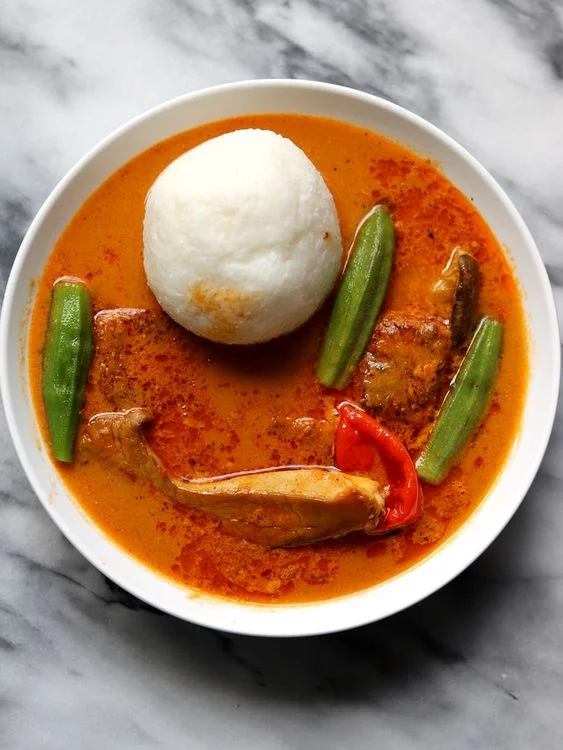
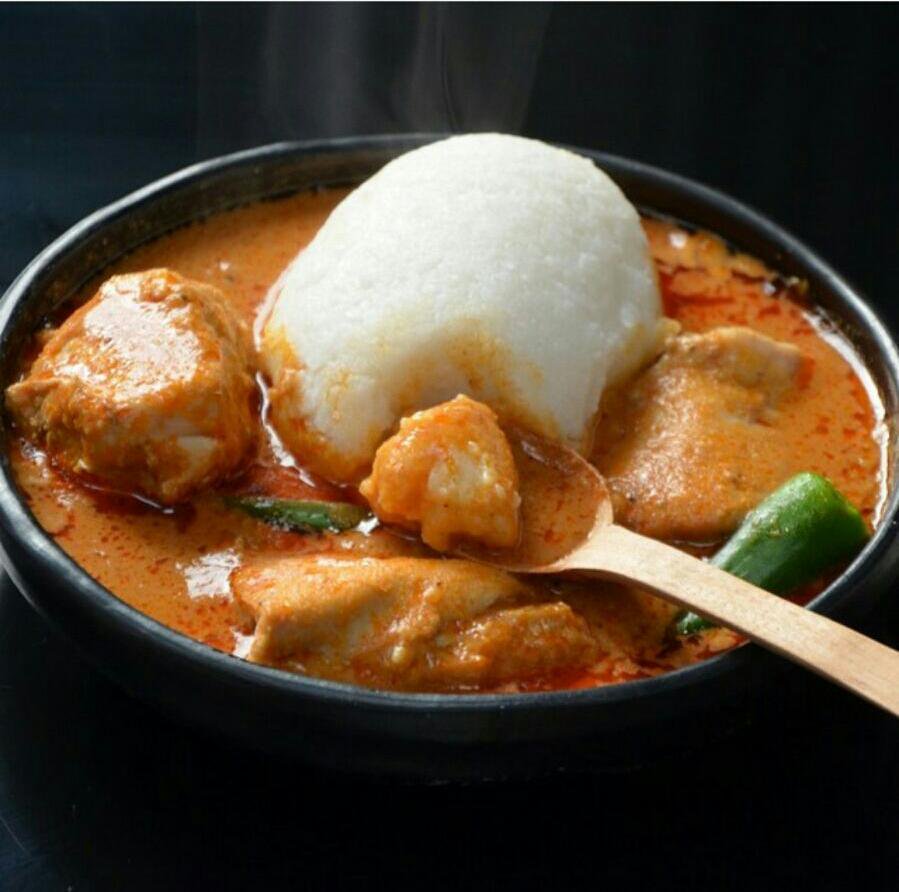

What it is: Cooked rice mashed and formed into smooth balls. Think of it as the easiest-to-eat version of Ghana’s starchy staples.
What it tastes like: Like rice, but stickier and formed into convenient, poppable balls.
How to eat it: Like fufu, tear off a piece (or eat a whole small ball), dip in soup, and swallow. Much less intimidating than fufu for first-timers.
Best paired with: Groundnut soup (peanut soup), palm nut soup, any of Ghana’s rich, hearty soups.
Why it’s great for beginners: If you’re intimidated by the texture of fufu or the sourness of banku and kenkey, omo tuo is your gateway drug to Ghanaian staples. It’s familiar (it’s rice!), easy to handle, and pairs with everything.
The Soups and Stews: Where the Magic Happens
7. Light Soup (Nkrakra)
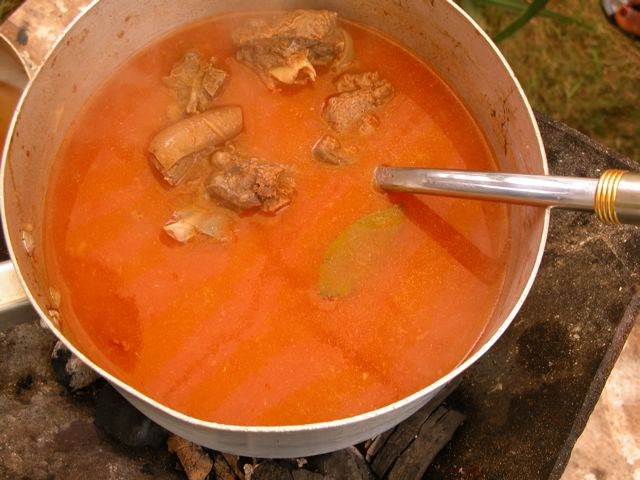

What it is: Don’t let the name fool you—there’s nothing “light” about this soup except the color relative to other Ghanaian soups. It’s a tomato-based soup cooked with onions, tomatoes, garlic, ginger, hot peppers, and usually fish or meat.
What it tastes like: Bright, spicy, aromatic, with a beautiful balance of tomato acidity and pepper heat. It’s lighter in body than palm nut or groundnut soup but intense in flavor.
Best paired with: Fufu, ampesi (boiled yam/plantain), omo tuo.
Cultural significance: Light soup with goat meat and fufu is considered a special meal, often served at celebrations or when you really want to impress someone.
Pro tip: The fish version (often with “one-man thousand” fish, so named because it’s said one man can’t finish it alone) is spectacular. The meat version with goat is equally amazing.
8. Groundnut Soup (Nkatenkwan)
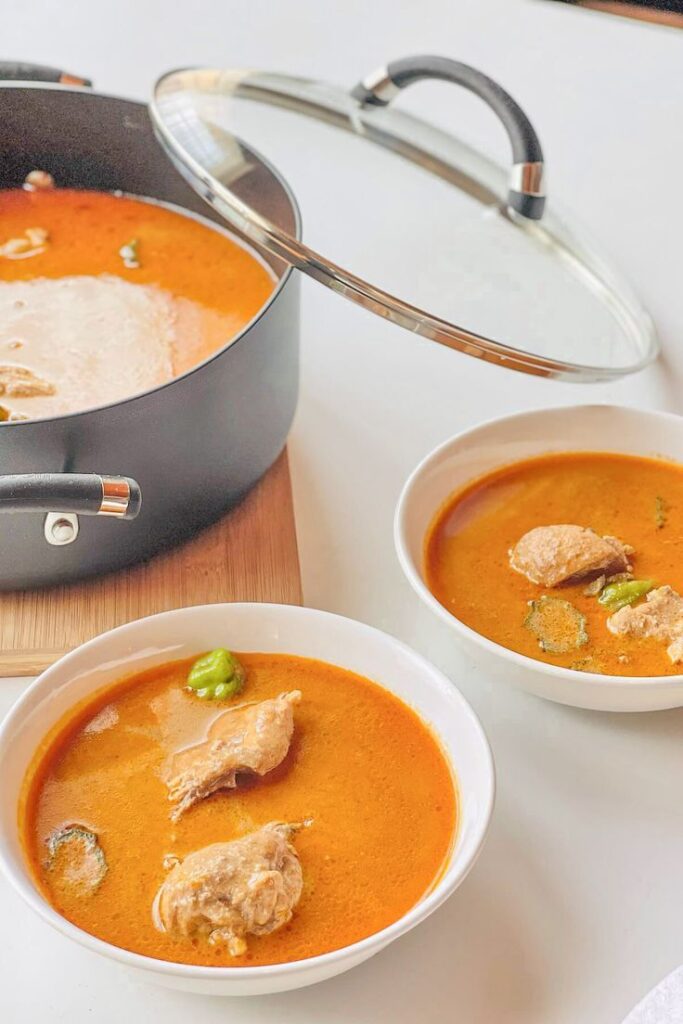

What it is: Rich, creamy soup made from roasted peanuts ground into paste, combined with tomatoes, onions, peppers, and usually chicken, beef, or goat meat.
What it tastes like: Like the most satisfying peanut stew you’ve ever had—nutty, slightly sweet, savory, with a thick, velvety consistency.
Best paired with: Fufu (this combination is divine), omo tuo, ampesi, even rice.
Regional note: This is popular all across Ghana, though every region and every household has their own variation.
Why it’s amazing: The combination of peanuts and tomatoes creates this incredible depth of flavor that’s simultaneously comforting and exciting. This is the soup that converts people to Ghanaian food.
9. Palm Nut Soup (Abenkwan)
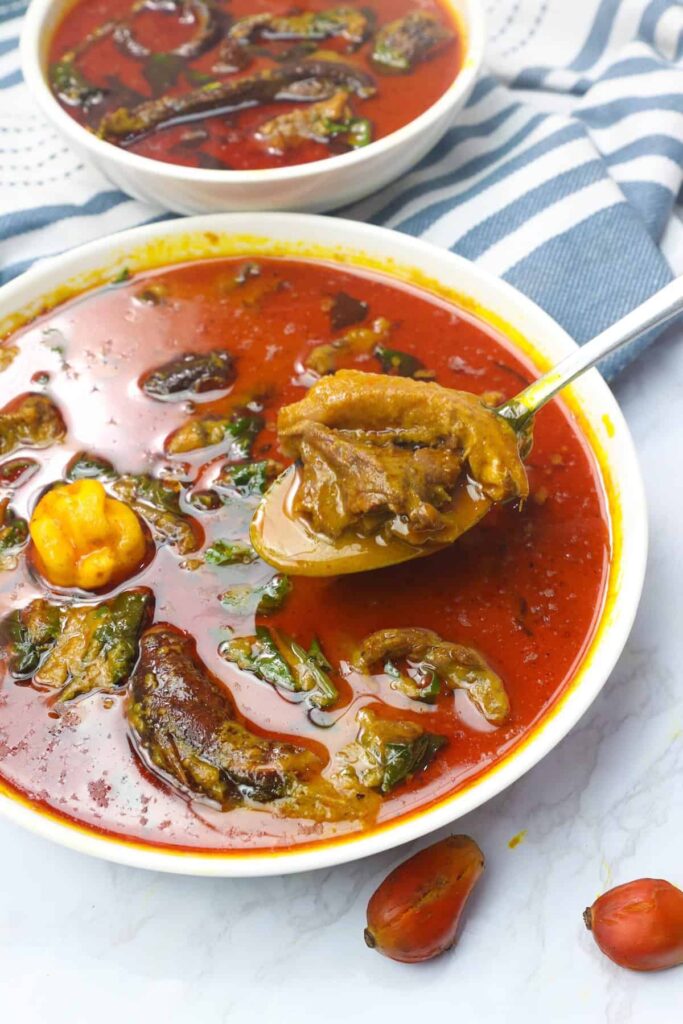
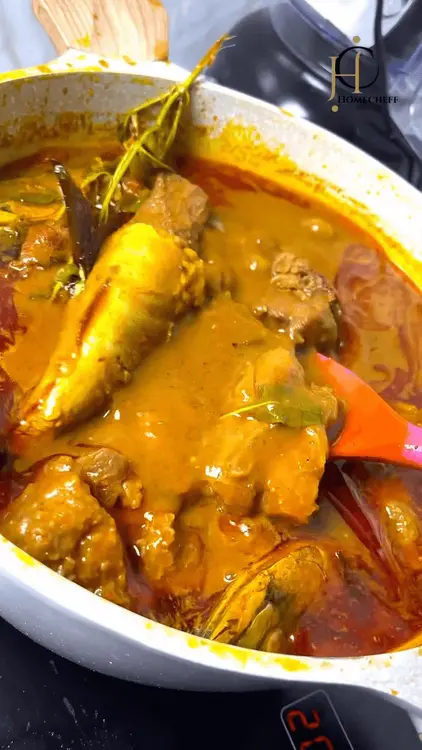
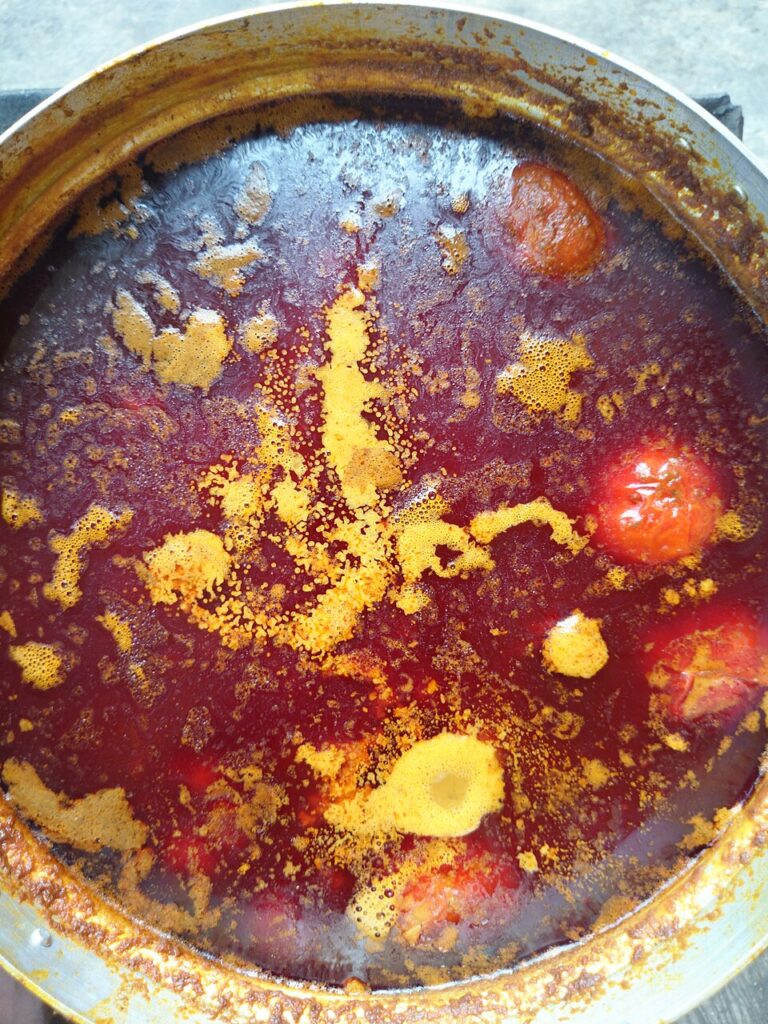
What it is: Soup made from palm nut pulp, creating a thick, orangey-red soup with a distinctive oily richness.
What it tastes like: Rich, oily (in the best way), slightly sweet from the palm fruit, with depth that comes from slow cooking with fish, meat, and spices.
Best paired with: Fufu, omo tuo, banku.
Pro tip: The oil that rises to the top isn’t a mistake—it’s part of the dish. Don’t skim it off. That’s where flavor lives.
Cultural note: This soup features heavily in Akan cuisine. The palm nut (different from palm oil, though both come from the same tree) gives it a unique flavor you can’t replicate with anything else.
10. Okro Stew (Fetri Detsi)
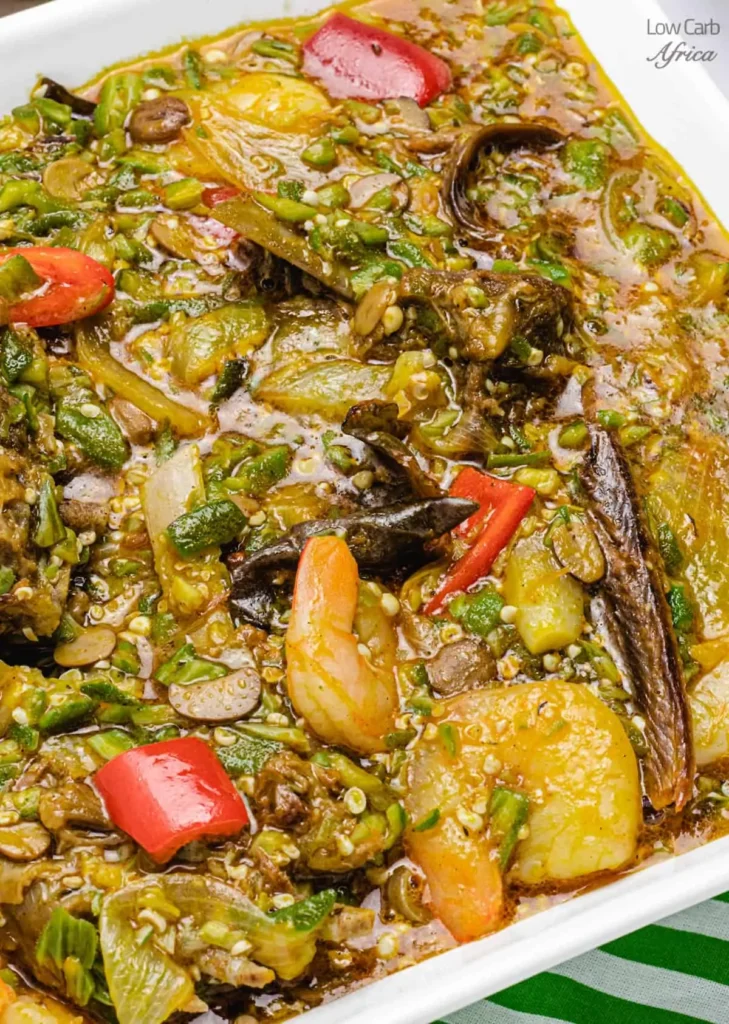
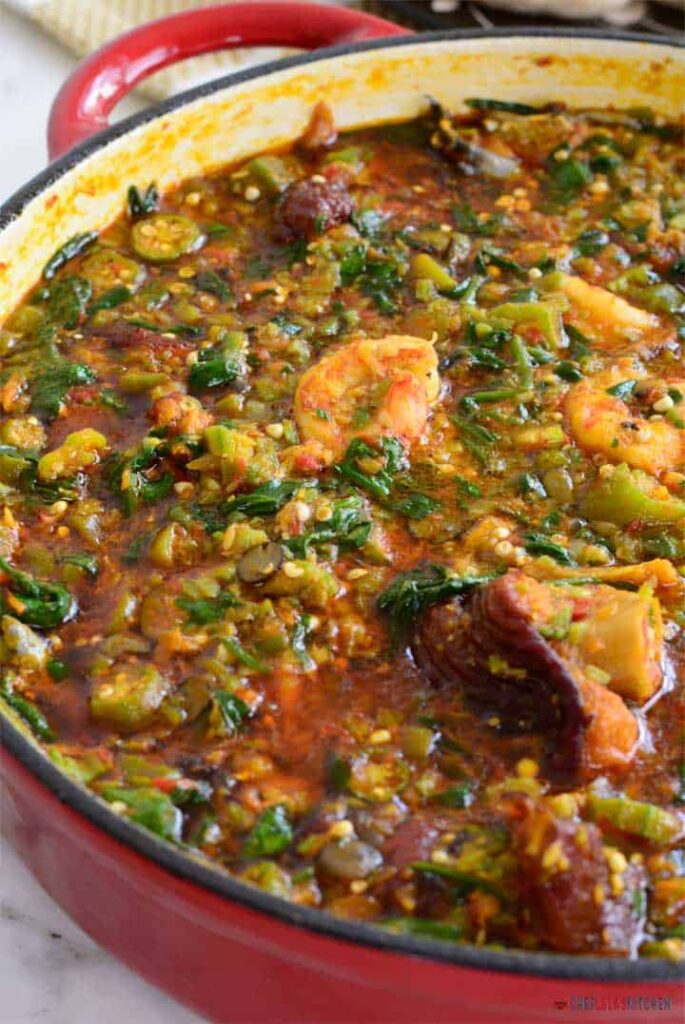

What it is: Stew made with okra, tomatoes, onions, fish or meat, and plenty of palm oil. It’s thick, slightly slimy (that’s the okra), and intensely flavorful.
What it tastes like: Earthy, rich, with the characteristic okra sliminess that you either love or learn to love. The palm oil adds depth and richness.
Best paired with: Banku (this is THE classic combination), fufu, rice.
The slime factor: Yes, okra is slimy. That’s kind of the point in Ghanaian cooking. The sliminess helps the stew coat your banku or fufu. If you hate okra’s texture, this dish probably isn’t for you. But if you’re even slightly open-minded, try it with banku—the combination is transcendent.
11. Kontomire Stew (Palaver Sauce)


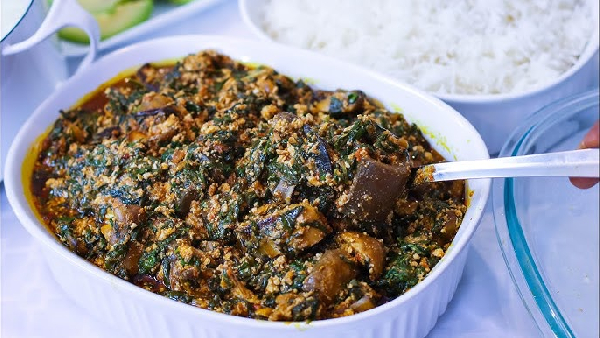
What it is: Stew made from cocoyam leaves (similar to taro leaves or collard greens), cooked down with palm oil, tomatoes, onions, smoked fish, and often egusi (melon seeds).
What it tastes like: Earthy, slightly bitter in a good way (like cooked greens), rich from the palm oil, smoky from the fish.
Best paired with: Boiled yam, boiled plantain, ampesi, rice, fufu.
Nutritional note: This is one of the healthier Ghanaian dishes, packed with greens, though the palm oil keeps the calorie count respectable.
Name confusion: “Palaver” might refer to kontomire specifically or to a similar dish made with other greens. It’s also sometimes called “ebunu ebunu” (green green).
12. Red Red (The Vegetarian-Friendly Option)
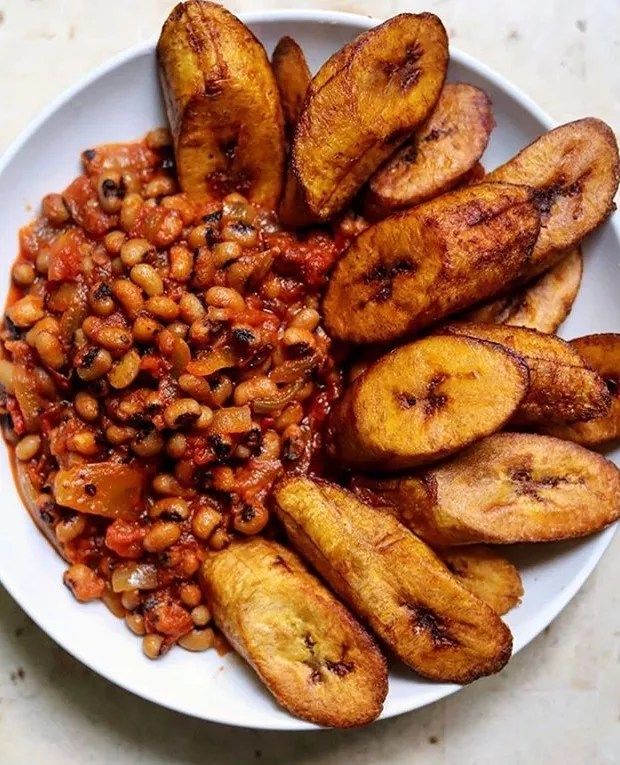


What it is: Cowpea beans (black-eyed peas or other legumes) cooked in a rich, tomato and palm oil stew, served with fried ripe plantains.
What it tastes like: Creamy from the beans, slightly sweet and savory from the tomatoes and palm oil, with the caramelized sweetness of fried plantains creating a perfect contrast.
Why it’s called Red Red: The combination of the red-orange palm oil tinting the bean stew and the bright orange of fried ripe plantains gives you red plus red.
Best paired with: Fried plantain (essential), gari (cassava granules), boiled plantain, sometimes rice.
Vegetarian note: While red red can be made completely vegetarian, many versions include smoked fish or dried fish for flavor. Always ask if you’re avoiding animal products. The vegetarian version is still delicious.
Where to find it: This is ubiquitous street food and chop bar fare. It’s also usually one of the cheapest substantial meals you can get in Ghana.
The Rice Dishes: Ghana’s Comfort Food
13. Jollof Rice (The Most Controversial Dish in West Africa)

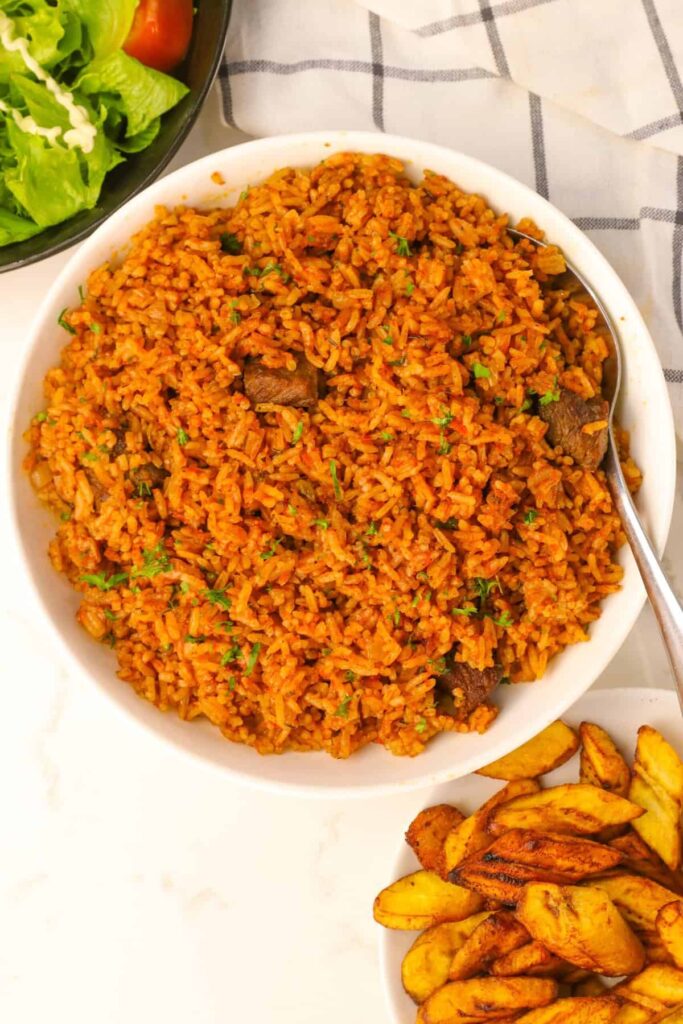

What it is: Rice cooked in a tomato and pepper stew with meat (usually chicken, goat, or beef) and spices until the rice absorbs all the flavors and develops a slightly crispy bottom layer (the socarrat, though Ghanaians don’t call it that).
What it tastes like: Savory, tomato-forward, slightly smoky, with the right amount of spice. Each grain of rice should be separate but infused with the stew’s flavor. The bottom layer should be slightly crispy (this is prized).
The Jollof Wars: Ghana and Nigeria have an ongoing, semi-serious debate about who makes the best jollof rice. Ghanaians will insist their version is superior (more refined, better spiced). Nigerians will insist the opposite (richer, more flavorful). The truth? Both are excellent, just different. Don’t get involved in this argument unless you want to start a fight.
Best paired with: Fried plantain, coleslaw or salad, grilled or fried chicken, boiled eggs, shito sauce.
Where to find it: Everywhere. Parties, restaurants, chop bars, street vendors. Jollof is celebration food and everyday food simultaneously.
Pro tip: If someone offers to make you jollof for a party, that person is showing love. If the jollof runs out at a party, people get genuinely upset. Plan accordingly.
14. Rice and Stew
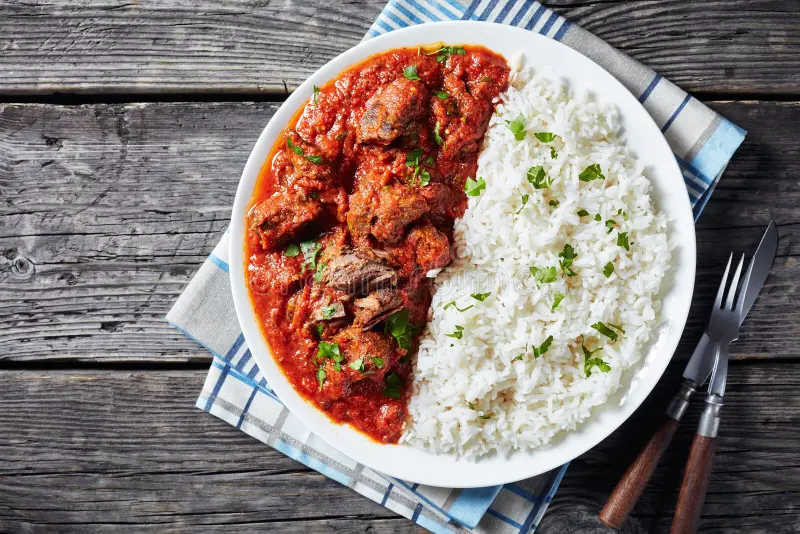

What it is: Plain white rice served with a rich tomato-based stew containing meat (chicken, beef, or goat), vegetables, and plenty of spices.
What it tastes like: Simpler and less integrated than jollof—the rice is plain, the stew is intense, and you get to control the ratio yourself.
Best paired with: Fried plantain, boiled eggs, gari, salad.
Why it exists: Sometimes you want plain rice. Sometimes the stew is so good it doesn’t need to be cooked into the rice. Sometimes you ran out of time to make jollof properly. All valid reasons.
15. Angwa Moo (Oiled Rice)

What it is: Rice fried in oil with onions, sometimes with vegetables or minced meat added. Think of it as Ghana’s answer to fried rice, but simpler.
What it tastes like: Savory from the onions and oil, with whatever additions you include. It’s comfort food—simple, satisfying, economical.
Best paired with: Pepper sauce (shito), fried eggs, tinned sardines.
When you’ll eat it: This is home cooking—quick, cheap, filling. Not usually restaurant food, but common in households.
The Proteins: Fish, Meat, and Everything In Between
16. Grilled Tilapia
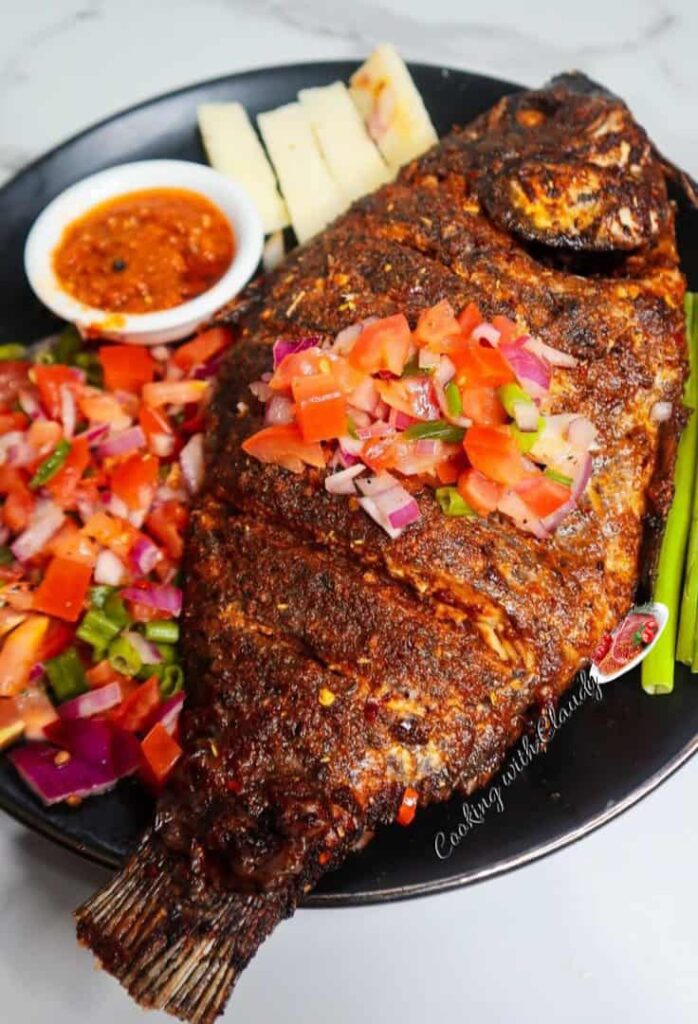
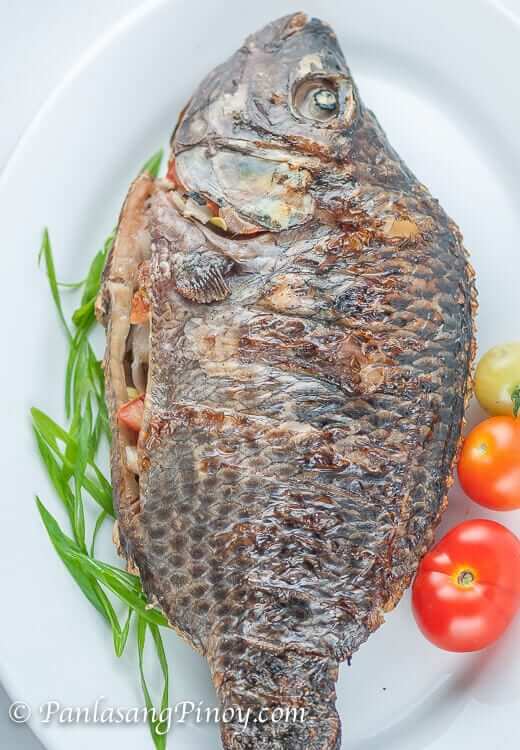

What it is: Whole tilapia fish (a freshwater fish common in Ghana’s lakes and rivers), scaled, seasoned with spices and peppers, and grilled over charcoal until the skin is crispy and slightly charred.
What it tastes like: Smoky from the charcoal, spicy from the pepper rub, with tender, flaky flesh inside and crackling, crispy skin.
Best paired with: Banku and pepper sauce is the classic combination. Also works with kenkey, fried plantain, or just eaten with your hands and cold beer.
Where to find it: Everywhere near water—lakeside restaurants around Lake Bosomtwe, beachside spots, Accra’s many tilapia joints.
How to eat it: With your hands. Pick the fish apart, dipping pieces in the spicy pepper sauce. Don’t be precious about it—this is messy eating at its finest.
Pro tip: The head and bones have lots of flavor. Many Ghanaians consider the head a delicacy. You’re not required to eat it, but don’t be surprised if locals fight over it.
17. Kelewele (Spicy Fried Plantains)
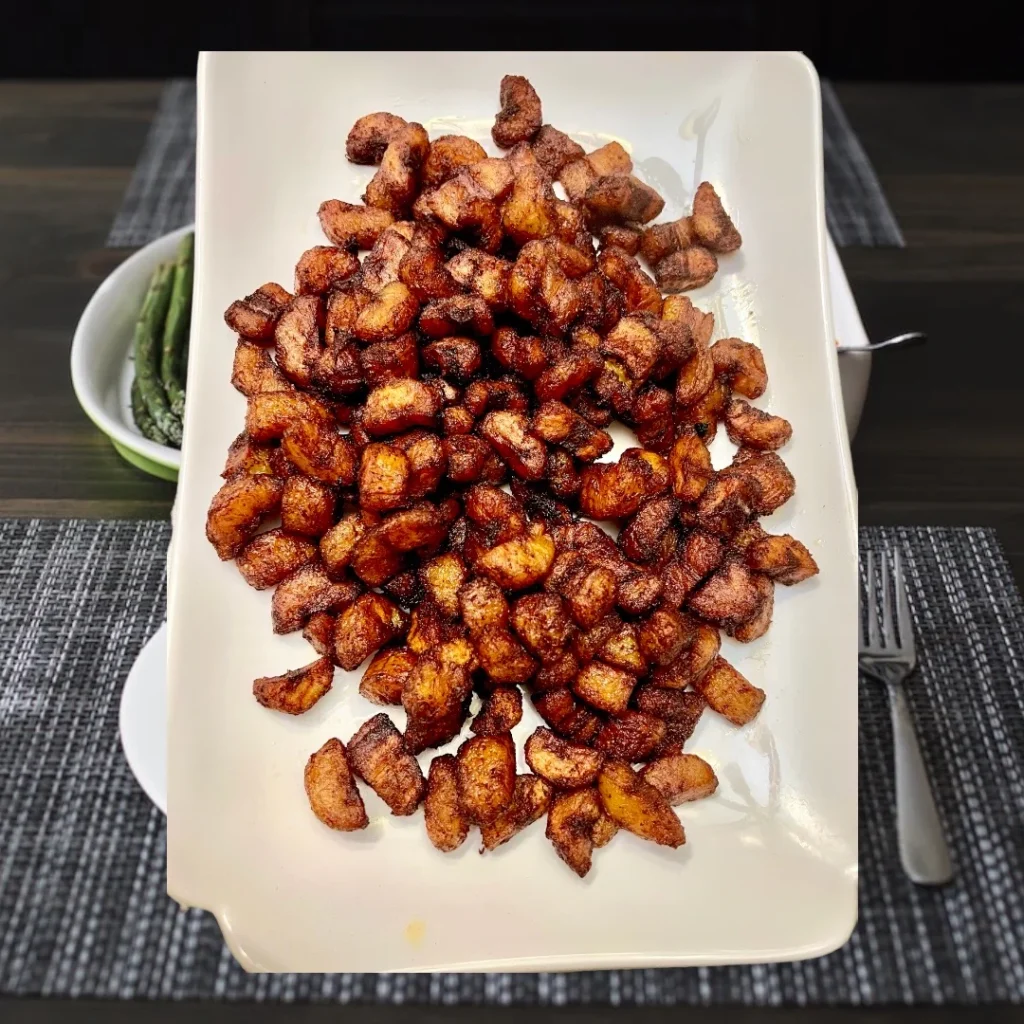

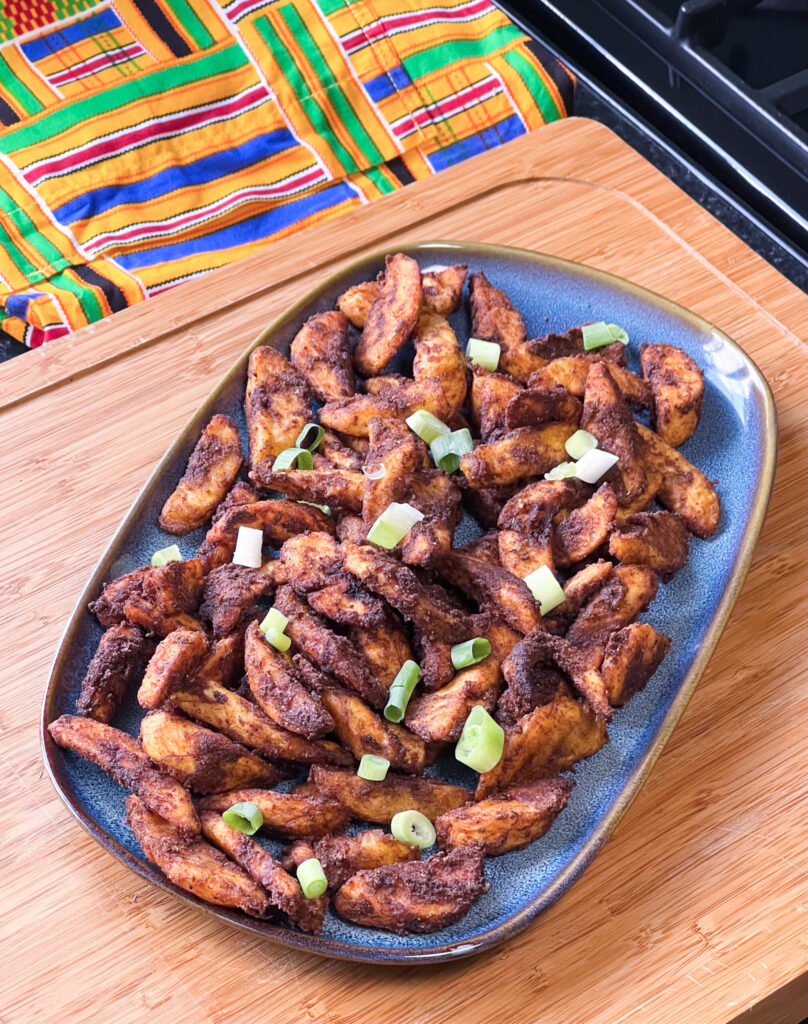
What it is: Ripe plantains cut into cubes, marinated in a mixture of ginger, cayenne pepper, and other spices, then deep-fried until caramelized and slightly crispy outside, soft inside.
What it tastes like: Sweet, spicy, gingery, with that perfect contrast between the crispy exterior and soft interior. Addictive.
When you’ll eat it: As a snack, as a side dish with rice and stew, with peanuts as street food, late at night when you’re slightly drunk and need something amazing.
Where to find it: Street vendors, especially in the evenings and at night. The smell alone will draw you to the vendor’s stand.
Pro tip: Eat it hot. Kelewele loses its magic when cold. Also, the spice level varies wildly by vendor—ask for a taste if you’re worried.
18. Chichinga (Suya)



What it is: Skewered beef, chicken, or goat meat rubbed with a spicy peanut-based spice mix (suya spice), grilled over charcoal.
What it tastes like: Smoky, spicy, nutty from the suya spice, with a great char from the grill.
Street food note: Chichinga vendors are usually Muslim men from Northern Ghana or neighboring countries. They’re masters of the grill, and their meat is consistently excellent.
Best paired with: Sliced onions, more suya spice, cold beverage of your choice.
How to eat it: Pull the meat off the skewer with your hand or your teeth, depending on how tender it is.
19. Wele (Cowhide/Tripe)
What it is: Cowhide (skin) that’s been cleaned, boiled until tender, then either stewed or added to soups.
What it tastes like: Chewy, slightly rubbery, absorbing the flavors of whatever it’s cooked in. It’s about texture more than taste.
Why it’s popular: Protein that’s cheaper than meat, traditional in many West African cuisines, and beloved by many Ghanaians. It features in light soup, added to red red, or stewed separately.
For adventurous eaters: If you like tendon, tripe, or other textured animal parts, you’ll probably enjoy wele. If you prefer conventional meat, you might want to skip it.
The Snacks and Street Food: Ghana’s Quick Bites
20. Bofrot (Ghanaian Doughnuts)
What it is: Sweet, yeasted dough fried into small, fluffy balls. Think doughnut holes but denser and less sweet.
What it tastes like: Slightly sweet, with hints of nutmeg, fluffy inside with a crispy exterior.
When you’ll eat it: Breakfast (often with koko), as a snack, anytime you see a vendor and can’t resist.
Best paired with: Koko (millet porridge), coffee, hot chocolate, or just eaten plain.
Also known as: Puff-puff in Nigeria and other West African countries.
Pro tip: Eat them fresh and hot. They’re best straight from the oil. Once they cool, they get denser.
21. Koose (Bean Fritters)
What it is: Black-eyed peas blended with onions, peppers, and spices, formed into patties or balls, then deep-fried.
What it tastes like: Crispy outside, fluffy inside, with the earthy flavor of beans and the heat of peppers. Savory and satisfying.
Best paired with: Koko (millet porridge) for breakfast, shito pepper sauce, or eaten on their own.
Also known as: Akara in Nigeria and other parts of West Africa.
Breakfast note: Koko and koose is a classic Ghanaian breakfast combination. The sweet, spicy porridge with the savory fritters is perfect for fueling a hard-working day.
22. Koko (Fermented Millet Porridge)
What it is: Millet flour mixed with water and allowed to ferment slightly, then cooked into a smooth porridge and seasoned with ginger, cloves, and sometimes chili pepper.
What it tastes like: Slightly tangy from fermentation, warming from the ginger, with a complex spice profile. It’s sweet (you add sugar and milk to taste) but also has depth.
When you’ll eat it: Breakfast, usually. Koko vendors set up in the mornings with their huge pots.
Best paired with: Koose, bofrot, bread.
Pro tip: The vendor cooks it without sugar or milk—you add those yourself to your preference. Start conservative with the sugar; you can always add more.
23. Boiled Corn and Coconut
What it is: Fresh corn on the cob, boiled until tender, served with fresh grated coconut.
What it tastes like: Sweet corn + fresh coconut = simple perfection. The coconut adds richness and a different kind of sweetness.
When you’ll eat it: As a snack, usually from street vendors carrying pots of corn on their heads.
Seasonal note: Best during corn season (usually July-September), when fresh corn is abundant and cheap.
Why it’s amazing: It’s simple, it’s healthy, it’s delicious, and it costs almost nothing.
24. Plantain Chips
What it is: Green or just-ripe plantains sliced thin and fried until crispy.
What it tastes like: Like potato chips but sweeter and with plantain’s distinctive flavor. Crunchy, slightly sweet, addictive.
Where to find it: Pre-packaged at shops and markets, or made fresh by street vendors.
Best with: Cold drink, groundnuts, or just eaten straight from the bag.
25. Nkate Cake (Peanut Brittle)
What it is: Roasted peanuts held together with caramelized sugar, formed into balls or bars.
What it tastes like: Crunchy, sweet, nutty, exactly what you’d expect from peanut brittle.
Where to find it: Street vendors, markets, packaged in small portions.
Tooth warning: This stuff is hard. If you have dental work, be careful.
The Drinks: Staying Hydrated (and Tipsy) in Ghana
26. Sobolo (Hibiscus Drink)
What it is: Drink made from dried hibiscus flowers (sorrel), boiled with water, ginger, and often other spices, sweetened to taste.
What it tastes like: Tart, slightly fruity, refreshing, with warming ginger notes. The color is a deep, beautiful red.
When you’ll drink it: Anytime you need refreshment. It’s sold cold by street vendors and in restaurants.
Health note: Hibiscus is said to have various health benefits, including lowering blood pressure. Whether that’s true or not, it’s delicious.
Also known as: Zobo in Nigeria, bissap in Senegal.
27. Asaana
What it is: Drink made from corn and caramelized sugar, creating a sweet, slightly fermented beverage.
What it tastes like: Sweet, with a unique corn flavor, slightly thick. It’s an acquired taste but refreshing once you’re used to it.
When you’ll drink it: From street vendors, usually during hot afternoons.
Pro tip: Drink it cold. Room temperature asaana is less appealing.
28. Brukina
What it is: Fermented millet drink, thick and creamy, sometimes mixed with milk.
What it tastes like: Tangy from fermentation, creamy, with the earthy flavor of millet. Nutritious and filling.
Cultural note: Popular in Northern Ghana and among Northern communities in urban areas.
29. Fresh Coconut Water
What it is: Water from fresh, young coconuts, drunk straight from the coconut.
Where to find it: Coconut vendors with machetes, all over Ghana, especially near the coast.
What it tastes like: Naturally sweet, refreshing, with that distinctive coconut water flavor that’s impossible to describe but impossible to mistake.
Pro tip: After drinking the water, ask the vendor to crack open the coconut so you can eat the soft, jelly-like coconut meat inside. It’s amazing.
30. Pito
What it is: Traditional alcoholic beverage made from fermented millet or sorghum, served in calabashes.
What it tastes like: Slightly sour, yeasty, earthy, with a low-moderate alcohol content. It’s an acquired taste.
Where to find it: Pito bars (usually someone’s house with calabashes out front), particularly in Northern Ghana.
Cultural note: Pito has ritual and social significance. It’s traditionally drunk from shared calabashes, making it a communal experience.
Health warning: The alcohol content varies, and hygiene standards in pito production… vary. Drink responsibly and at your own risk.
Bonus Dishes and Honorable Mentions
Tatale – Ripe plantain fritters mixed with flour, ginger, and pepper, fried until golden.
Mpoto Mpoto – Yam casserole cooked with tomatoes, onions, peppers, and oil until it becomes a thick, savory porridge.
Wasawasa – Northern Ghanaian dish made from dried yam peelings ground into flour, cooked and served with pepper sauce.
Akple – Ewe dish made from corn dough, similar to banku but firmer, typically served with okro soup.
Kokonte – Made from dried, powdered cassava, cooked into a dark brown, earthy paste. It’s an acquired taste and historically considered “poor people’s food,” though it’s nutritious and filling.
Tsofi – Turkey tails, fried or stewed. Popular street food in Accra despite being criticized as unhealthy due to high fat content.
Yakayake – Steamed grated cassava, an Ewe dish often served with kontomire stew.
Where and How to Eat: Practical Guide
Chop Bars: Local eateries serving traditional Ghanaian food at reasonable prices. Usually display the day’s dishes in large pots, and you point at what you want. Don’t expect menus or air conditioning, but expect authentic food and generous portions.
Street Vendors: Everything from women carrying banku on their heads to guys grilling chichinga on corners. Quality varies, but this is where some of the best food is. Go where you see lots of locals eating.
Restaurants: Exist in all major cities, offering traditional food in more comfortable (and expensive) settings. Good for first-time experiences when you want guidance and A/C.
Ordering Tips:
- “Small” portions are usually big enough
- Always ask about spice levels if you’re sensitive
- Don’t be afraid to ask what something is—Ghanaians are generally happy to explain
- Cash is king, especially at chop bars and street vendors
- Food prices in Ghana are generally cheap by Western standards
Etiquette:
- Wash your hands before eating (many places provide handwashing stations)
- Right hand for eating
- It’s okay to share dishes communally
- Finish your food or take it home—wasting food is frowned upon
- Compliment the cook if the food is good
Food Safety:
- Drink bottled water
- Avoid raw vegetables unless you trust the washing
- Cooked food that’s hot is generally safe
- Trust your gut (literally)—if something seems off, don’t eat it
- Most visitors have minor digestive adjustment, but it’s usually fine
The Real Flavor of Ghana
Ghanaian food isn’t just about sustenance. It’s about community, tradition, resourcefulness, and flavor. It’s about sitting on a plastic stool under a tree, eating fufu with your hands, sweating slightly from the pepper, and feeling more satisfied than you’ve felt after any Michelin-starred meal.
Yes, you’ll probably get sauce on your hands. Yes, your spice tolerance will be tested. Yes, you might struggle with the textures at first. But none of that matters when you’re sharing a bowl of groundnut soup with locals, or when you taste perfectly grilled tilapia with banku for the first time, or when you discover that kelewele at 11 PM might be the best thing you’ve ever eaten.
The secret to enjoying Ghanaian food? Stop thinking about it like a tourist trying to tick off a list. Start thinking about it like someone who’s genuinely hungry and willing to try something new. Ask questions. Make mistakes. Laugh at yourself. Order too much. Get seconds. Talk to the vendors and cooks.
Ghanaian food is meant to be enjoyed, shared, and celebrated. Don’t be intimidated by unfamiliar textures or intense spice levels or the social pressure of eating with your right hand. Just dive in. The worst that happens is you discover you don’t like something (looking at you, kontomire’s bitter undertones). The best that happens? You fall in love with some of the most satisfying, soul-warming food on the planet.
Welcome to Ghana. Now eat.

